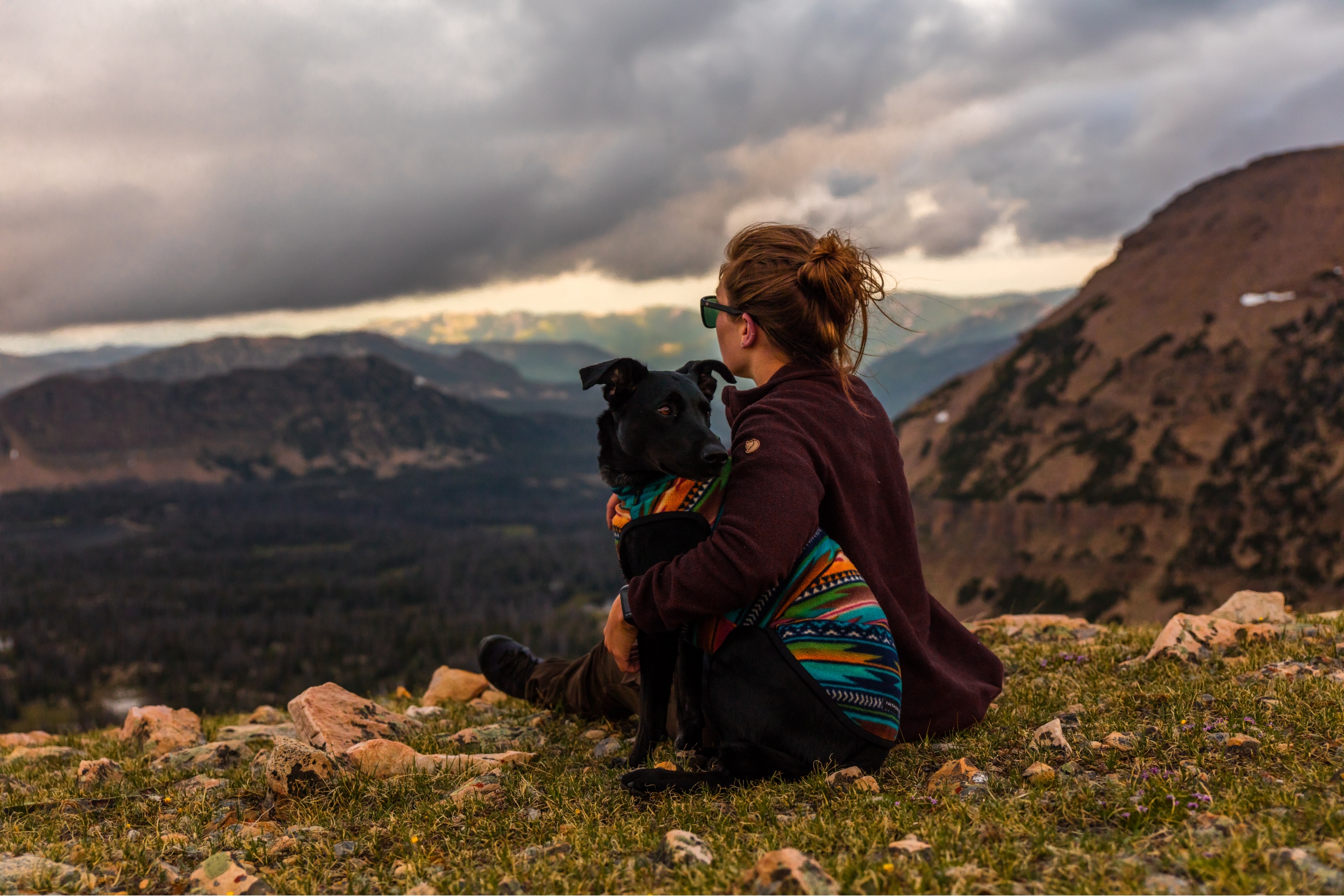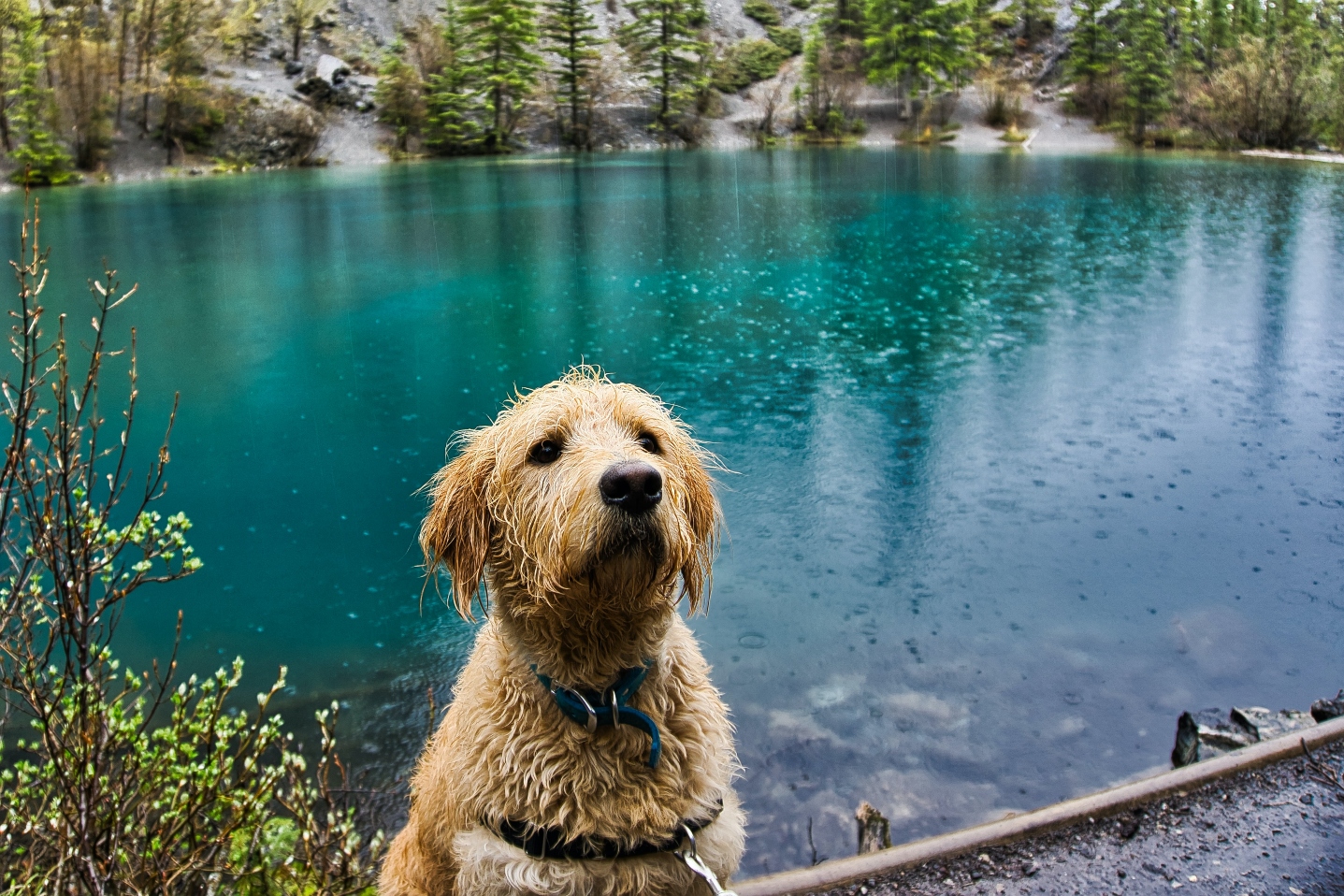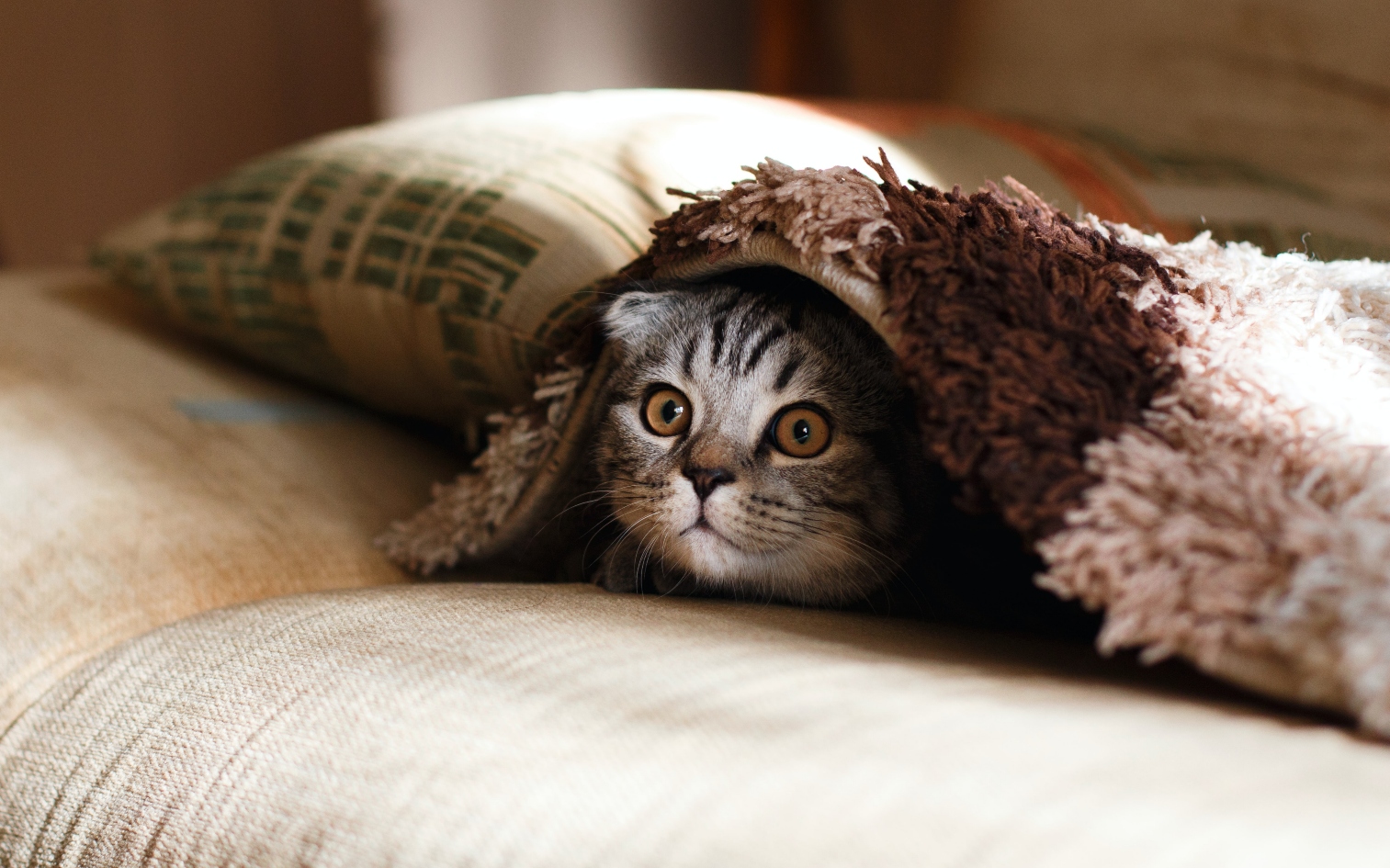
How to keep old pets safe in a storm
5th April, 2022
Winters here in the UK often bring major storms – Storm Bella, Storm Arwen and Storm Eunice are just three particularly dramatic and destructive weather events from recent memory. In fact, although storms – with their strong winds, torrential rain, and sometimes thunder and lightning – are commonest in winter, they can occur at other times of the year too.
We are all fairly familiar with the advice on how to keep ourselves safe in a storm: secure loose objects, fasten doors and windows shut, stay indoors as much as possible, and avoid driving where you can. But how do these dramatic, noisy and often violent weather events affect our pets – and how can you keep your older dogs and cats safe and reassured during a storm?
Read on for our extensive guide to helping your older dog or cat through the worst of a major storm. We've got plenty of advice on keeping your beloved pets calm during what can be anxious times. We also stress the importance of microchipping, for any animals that might go missing during a storm. And if your pet injures themselves trying to escape the noise, our pet insurance for older dogs and cats can help to cover the costs of any treatment they might need.

Why do pets get anxious in storms?
First things first, though: what is about storms that makes our pets so anxious? You won't be surprised to know that it's the noise that stresses out many domestic animals. You may be familiar with this, from your cat or dog's behaviour whenever there are fireworks going on outside: loud bangs like these are likely to make animals such as dogs and cats quite anxious, and send them cowering off into the quieter, more tucked-away parts of the house.
But why are these loud noises so hard for our pets to handle? Well, essentially, it's because hearing in small animals is more sensitive than it is in us humans. What sounds moderately loud to us will sound louder to them. Added to this, in the case of a storm in particular, is that the noise of the thunder will come as a complete shock to them – whereas we are always warned, by the lightning that precedes it.
There is also evidence to suggest that the static electricity that builds up before a storm, along with the changes in barometric pressure, can make our pets anxious.
How can you recognise stress and anxiety in your older pet?
If a storm is raging outside, you may be able to recognise certain signs of anxiety in your pet, and take the steps above to calm them down. But what are the signs that you should be looking out for?
Telltale signs of 'storm stress' in a dog would include shaking, pacing around restlessly, and panting more than usual. They may also drool and/or yawn more than usual. You may see them with their tail between their legs, a common sign of unhappiness in dogs. They might whine and/or bark to show their anxiety and fear. Lastly, dogs can often drink more during times of anxiety like this – so make sure that their water bowl is well filled.
A stressed or anxious cat, on the other hand, is likely to become more withdrawn, and hide away more than usual. They may seem hesitant to do the things they'd normally do without thinking – using their litter tray, for example, or going through the cat flap, or sitting on your lap. They might scratch the furniture, and/or meow, hiss or growl. You may see them adopting a crouched, tense posture.
There are certain things that you can do to help keep your pets as calm and reassured as possible during a thunderstorm. The advice is, broadly, similar for both cats and dogs. Let's look into how to reassure both animals during a heavy storm.
5 ways to help older cats during a storm
1. Give them a route back into the house at all times
Many cats like to spend a lot of their time outdoors. During and just before a storm, however, you must make sure that they can easily get back inside whenever they need to.
A cat flap is the obvious solution here. If you don't have one of these, try to base yourself as much as possible in the room that gives access to the garden, so that you can be ready to let them in as soon as they appear at the door or window. Getting caught in a sudden downpour will be a very unpleasant, and potentially frightening experience for a cat.
2. Make sure their microchip is up to date
If your cat does find themselves out and about during a heavy storm, they may panic and get themselves lost. In case this does happen, you should make sure your cat's microchip details are up to date. This will mean that anyone who does eventually find your feline friend will be able to take them to a local vet, who will be able to look up your cat on the microchip database and contact you.
Indeed, microchipping your cat is an essential part of cat ownership – we would put it right up there with securing some pet insurance for older dogs or cats. In fact, microchipping is now a legal requirement under recent Government legislation.
The new laws dictate that owners must get their cat microchipped before the animal reaches 20 weeks of age. Their contact details must be stored, and kept updated, on one of the various pet microchip databases. Any owner whose cat is found not to have been chipped will have a grace period of 21 days to have a chip implanted – otherwise, they may face a fine of anything up to £500.
Another compelling reason to get your cat chipped is that some insurers may require it before they are able to provide you with pet insurance for older dogs and cats.
The good news is that it's pretty simple to update your cat's microchip details. This can be done over the phone, by post, or online, with whichever database you used to register the animal.
By the way, if you're having trouble remembering which database you used to register your cat, don't worry. As long as you have your cat’s microchip number stored safely, you can use it to search for the relevant database on the Check a Chip website.
3. Keep your cat inside during the storm
As we discussed, many cats love to spend much of the day out and about – but the middle of a storm really isn't a good time to go wandering. If your cat is already indoors when the storm gets going, lock your cat flap and close all doors and windows. One thing to think about now is a litter tray. You may not typically need one if your cat spends a lot of time outdoors, but if they are now facing several hours' enforced confinement they may well need a tray handy when nature calls!
4. Make a den or safe area for your cat
When they are feeling anxious, older cats often like to get somewhere high up and/or shut away. Consider making them a den of their own, high up on a shelf or inside a cupboard (for added warmth and security, a boiler or airing cupboard is a great option).The den itself can be as simple as a large cardboard box, with its opening facing directly outwards for easy access. You can then fill it with soft furnishings – cushions, blankets – and perhaps one or two of your feline’s favourite toys to keep them occupied and distracted. The PDSA website has some great advice on how to make a cat den.
5. Use a cat pheromone
Consider using a cat pheromone like Feliway at home. These plug-ins diffusers can help stop scratching, hiding or spraying behaviours during an anxious period. You could also try distracting and relaxing them with catnip toys (they’ll go crazy for a while and then crash out), or use herbs like Valerian or Chamomile to try to calm them down. If you’re not sure about giving your cat herbs like this, talk to your vet or our 24-Hour Vet Helpline.

5 ways to help older dogs during a storm
1. Plan your walks around the weather
Be aware that a storm is going to mean a period – which could be anything from a few minutes to most of a day – where walking won't be an option. However, according to your dog's breed and personality, they are still likely to need their once, twice or even thrice-daily exercise.
So, keep a very close eye on the forecast, and try to plan your walks around the worst of the weather. A walk in the calm period before the storm will stand your dog in good stead for the next few hours, when they will probably need to be cooped up indoors.
2. Keep your dog inside during the storm
You and your dog should not be outside during the peak period of the storm. It can be dangerous out there, with the possibility of falling debris and electrical cables, for example. What's more, your dog is likely to find the experience of being out in a storm pretty stressful, and may become unpredictable and hard to control.
Keep them inside while the worst of the storm passes. Your dog may get a bit restless, of course, and start pawing at the door for walkies, or bringing you the lead and collar with an expectant look on their face. But stay firm: it won't be safe for them out there. What you can do, instead, is keep them distracted indoors with a few favourite toys and games.
3. Use a reflective lead and collar for walkies
In the hours before the storm, the gathering rain clouds can make for some pretty poor light conditions. It's essential that your dog can be seen in the gloom, so a bright reflective lead and collar set will serve you well here.
4. Don’t forget to update their microchip
It has been a UK legal requirement for owners to microchip their dogs since April 2016. As with cats, failing to microchip your dog and keep their details updated can result in a fine of up to £500. And, once again, you will probably find that evidence of microchipping is essential when you come to arrange your pet insurance for older dogs.
The chip should be fitted by a professional – by a vet, for example. The procedure – which involves inserting a chip around the size of a grain of rice, just under your pet's skin – typically costs around £10 to £15. In addition, however, some charities will microchip your dog for free. These include the Battersea Dogs and Cats Home and Blue Cross centres.
Again, similarly to our advice with cats above, provide some sort of den or refuge where your dog can take cover if it all gets a bit much. The same rules broadly apply for a doggy den as for a kitty cave: make it easily accessible and full of soft cuddly surfaces – and have some favourite toys close at hand to distract your pooch from the meteorological fireworks going on outside. You might even want to leave some of your clothes in there, so
that they can be comforted by your scent.
Once again, close windows and curtains, and – if the thunder and wind are likely to distress your dog, put some music or the telly on to drown out some of the worst of the noise.
5. Use a dog appeasing pheromone
You could try a dog appeasing pheromone to help your older dog settle down. Available from all good pet stores, you can use the spray on your dog’s bedding or toys to help keep them calm during stressful periods such as storms, travelling and more. Alternatively, there are plug-ins available that you can use while you’re at home.
Adaptil is a well-known brand, but you’ll find lots of other makes, too. Ask your vet for advice on the best pheromone to use for your particular dog.
Supplement this with lots of reassurance and cuddles and give them a place where they can hide away until the storm blows over. And a treat or two to encourage calm behaviour wouldn’t go amiss.

Medical treatments for 'thunderstorm anxiety' in dogs and cats
Any animal that seems to feel consistent, and serious levels of 'thunderstorm anxiety' may need some form of medication to help. If your dog, or other pet, seems to get in a bad state every time a storm comes along, it may well be worth talking to a vet about what medication might work best.
Another option is sound therapy, which can gradually desensitise an animal to unwelcome noises like this. This may be arranged through either a vet or a qualified animal behaviourist.
If you’re a Petwise customer, remember that one of the benefits of our pet insurance for older dogs and cats is a 24-Hour Vet Helpline. This means that you can call the dedicated team, whenever you have a health or wellbeing concern about your pet, and one of our team of trained veterinary nurses will be ready to listen and advise.
If you need to leave your home during or after a storm
It’s a relatively rare event in the UK, but the fact remains that during some extreme weather events there is a chance that you may need to leave your home for a period of time. This may be because the house is at risk of flooding, for example, or because damage from storms is making it dangerous to remain in the house.
If this does ever happen, it's likely to be a very anxious time, both for your household and for your pets. However, there are a few steps you can take to try to ensure that upping sticks and leaving is not too stressful.
Cats should be placed in secure pet carriers, for example, so that they can be evacuated safely. If you do need to leave quickly, make sure you are familiar with your cat's favourite hiding places during a storm, so you can track them down quickly and leave safely together.
In the case of dogs, you should have them on secure leads, so you don't become separated from them. They may panic, after all, and try to get away from you – and you definitely don't want your dog running around, frightened and confused, during a dangerous storm. Make sure that they have a well-fitting collar or harness, and that they are wearing a name tag with your correct contact details written on it.
If you find that you have time to pack before leaving the house, try to remember the basics for your pet – food, medications, lead, toys and treats.
If the worst happens and you have to leave without your pets, make sure you leave them in a safe room upstairs, away from any flood risks, and give them plenty of fresh water and food. Then, as soon as you’re safe, contact the rescue services and let them know that your pet is still in the building, so that the two of you can be reunited.
The PDSA has some good advice on how to look after your pets during a flood.
Pet insurance for older dogs and cats – for whatever life throws at you
Noisy storms and bad weather can pose a risk for older pets. If they’re scared or confused, they may bolt and hurt themselves trying to escape from the unfamiliar sounds.
Thankfully, our pet insurance for older dogs and cats is on hand to help with any accidents or injuries that may occur.
Other benefits include:
- 24-hour vet helpline
- No upper age joining limit
- Dental cover as standard
Why not get a quote from us today and make sure your old friend is protected?